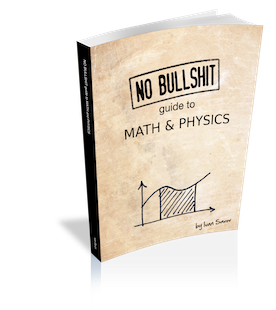The page you are reading is part of a draft (v2.0) of the "No bullshit guide to math and physics."
The text has since gone through many edits and is now available in print and electronic format. The current edition of the book is v4.0, which is a substantial improvement in terms of content and language (I hired a professional editor) from the draft version.
I'm leaving the old wiki content up for the time being, but I highly engourage you to check out the finished book. You can check out an extended preview here (PDF, 106 pages, 5MB).
Exercises
Q1: Two positive charges $Q_1$ and $Q_2$ are held together by a string of length $d=10$[cm]. The first charge is $Q_1=5$[C] and the tension in the string is equal to $1.348132768\times 10^{13}$[N]. Find the value of $Q_2$.
A1: $Q_2=\frac{F_e\;d^2}{5k}=+3$[C].
Q2: Suppose that a charge $Q_1=+5$[C] is placed at the origin and a charge $Q_2=-3$[C] is placed at distance $d$[m] along the $x$ axis. There exists a point $x$ which lies somewhere between the charges $Q_1$ and $Q_2$ where the electric potential ($V$) is equal to zero. Find the value of $x$.
Hint: $V_{\text{\tiny tot}}(x)=V_1(x)+V_2(x) = \frac{kQ_1}{x} + \frac{kQ_2}{d-x}$.
Ans: $x=\frac{5}{8}d$.
Q3: Suppose that we have same situation as in the above question:
a charge $Q_1=+5$[C] is placed at the origin and a charge $Q_2=-3$[C] is placed at distance $(d,0)$[m].
Find the find the point $x$ where the strength of the electric field is equal to zero.
A3: $x=\frac{(5+\sqrt{15})}{2}d\approx 4.4365d$.
Q4: A charge $Q_1$ is placed at the origin of the coordinate system,
and a second charge $Q_2$ is placed at distance $d$[m] along the $x$ axis.
a) Find the magnitude of the electric force between $Q_1$ and $Q_2$.
b) Find the electric potential energy stored in this configuration.
c) Find the electric field $\vec{E}$ at a point $P$ which has $x$ coordinate
$x=5d$.
This point P is situated at a distance $4d$ from the charge $Q_2$.
d) Find the electric potential ($V$) at the point P.
e) If a third charge $Q_3$ is placed at the point $P$,
what will be the electric potential energy of the the configuration of the charges.
Use your answers from part b) and d) to answer this question.
A4: a) $F_e=\frac{kQ_1Q_2}{d^2}$[N],
b) $U_{12}=\frac{kQ_1Q_2}{d}$[J],
c) $\vec{E}_{\text{\tiny tot}}(P)= \vec{E}_1(P) + \vec{E}_2(P)
= \frac{kQ_1}{(5d)^2}\hat{\imath}+\frac{kQ_2}{(4d)^2}\hat{\imath}$ [N/C].
d) $V_{\text{\tiny 12}}(P) = V_1(P) + V_2(P) = \frac{kQ_1}{5d}+\frac{kQ_2}{4d}$ [V].
e) $U_{\text{\tiny tot}} = U_{12} + U_{13} + U_{23} = \frac{kQ_1Q_2}{d} + Q_3V_{\text{\tiny 12}}(P)$ [J].
